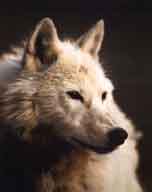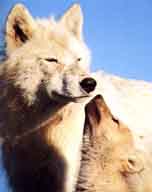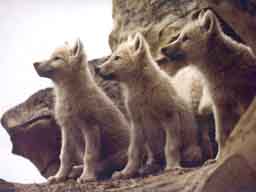- Two questions immediately come to mind when you are trying to photograph a wolf pack. First, how do you find a pack? And second, assuming you find one, will the pack members accept your presence without altering their behavior?
- As soon as the Geographic had given me the nod to do an Ellesmere story, I called up fellow Minnesotan, L. David Mech, a wolf scientist and author of The Wolf. The Ecology and Behavior of an Endangered Species (University of Minnesota Press, 1970). Over the 18 years we'd known each other, Mech and I had always hoped to find a wolf situation that might lend itself to a successful integration of science and photographic aesthetics. In Minnesota, the latter component had simply proved impossible. Not only are the wolves extremely shy and elusive, but the dense spruce and aspen terrain make unobstructed photographs nearly unattainable.
- The one occasion in 20 years when I actually had a chance to photograph a wild Minnesota wolf in the open illustrates some of the problems of wolf photography in even a best-case scenario. It happened several years ago when I was snowshoeing across a frozen lake near my home in Ely.
- A large male timber wolf emerged from the forest a hundred yards away. With the wind blowing from his direction, he was unable to catch my scent. It was a rare instance where I saw the wolf before the wolf saw me. Immediately, I pitched myself forward in the deep snow and remained motionless. Within seconds, of course, he spotted a peculiar, out-of-place lump in his otherwise pristine domain. The wolf assumed a crouch. For the next ten minutes, with his ears cocked forward like radar sensors, he stalked me. I remained perfectly still as he moved closer and closer. Finally, when he had approached to within 30 yards, I started taking photographs.
- At this point, most animals would run like crazy. The wolf's reaction, however, was as different as it was unexpected. I hesitate to anthropomorphize, but the only word I could think of to describe his response was embarrassment. He didn't run, he just turned broadside to me, never once showing the slightest fear. Then, very slowly, as if trying to salvage some dignity after being hoodwinked by a human ape he'd perhaps mistaken for a moose carcass, he walked back to the forest edge and disappeared.
- The photographs of this episode turned out terribly. Because of the angle of the wolf's approach and retreat, I had to shoot directly into the sun. Moreover, the wolf was wearing a prominent radio collar that seemed about as natural on him as a wristwatch. The photographs were never published.
- Fortunately, the situation in the high Arctic promised to be vastly different. My single experience with them had already taught me that the Arctic wolves, at least in this region, were not yet afraid of humans. Equally important from a photographer's point of view, the largest trees on much of Ellesmere are the Arctic willows: teninch botanical midgets whose trunks grow parallel to the ground to foil the constant wind. A 50-year-old Arctic willow might have a trunk no thicker than a child's finger; I'd like to see a sheepish wolf try to hide behind one.
- I returned to Ellesmere in April to look for wolves while simultaneously working on the "white animals of Ellesmere" story. During this trip, I made numerous contacts with a pack of seven adults, six of whom were almost certainly the same wolves whose path I had intersected earlier. Over time, they became habituated to my presence, almost to the point where they ignored me an ideal state of affairs. In early June, Mech agreed to return to Ellesmere and search for the pack's den.
- Since the wolves were almost certain to lead him right to it, it was a relatively easy assignment.
- Except for a period of denning in the spring, wolf study can be extraordinarily difficult. For most of the year, a pack roams over its entire territory, which can be thousands of square miles. Each spring, however, the mother must take to the den to have her pups, while the rest of the pack remains nearby to help bring food to the pups after they are born For a couple brief months, then, the pack is focused geographically.
- Compared to the nearly impossible task of finding a wolf den in forested country, finding the Ellesmere den was easy. Mech and I immediately realized that this den would provide an excellent observatory for wolf behavior - assuming that our presence during this sensitive time did not cause the wolves to prematurely abandon their temporary home. I also knew the den would provide a superb backdrop for wolf portraiture.
- Because the Arctic permafrost makes digging deep into the ground almost impossible, good wolf den sites are rare and extremely valued by a pack. This den looked as if it had been used by wolves for hundreds, perhaps thousands, of years. Such allegiance was understandable, for the den was almost perfect: a kind of Frank Lloyd Wright masterpiece of canine real estate set high on a hill.
- It was probably formed by a glacial retreat. A broad sedimentary rock outcropping provided what was in essence a porch that funneled down into an entrance into the earth just large enough to accommodate a pregnant wolf. A hungry polar bear, in other words, could not squeeze in to make a snack out of the growing pups. Inside, an immaculate, bug-free layer of sand covered the ground well into a 20-foot cave. The rock walls offered protection from the bitter cold of spring and the occasional heat of summer.
|



